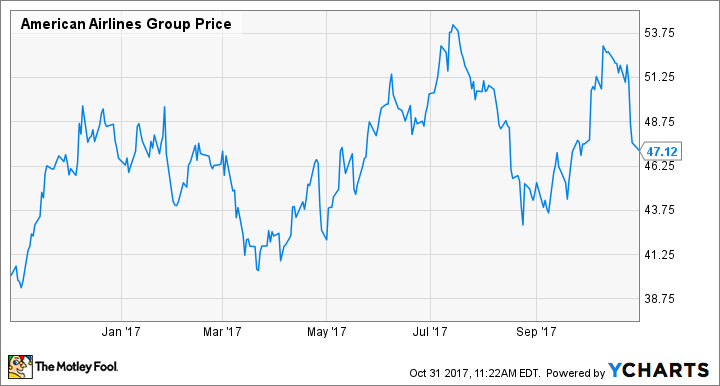Last Thursday, American Airlines (AAL 0.11%) reported a third-quarter profit that was slightly higher than what analysts were expecting. The company's fourth-quarter margin forecast also came in ahead of analysts' expectations.
Nevertheless, American Airlines stock fell on the day of the earnings report, and it has continued sliding since then, falling well below its 52-week high. Here's why shares of the world's largest airline could continue to struggle.
American Airlines stock performance. Data by YCharts.
Profit set to sink again
Most U.S. airlines have faced margin pressure during 2017, due to a combination of rising fuel prices, higher labor costs, and a choppy unit revenue environment. However, American Airlines and United Continental (UAL -2.31%) have stood out from the pack -- in a bad way. Both carriers' pre-tax margins are on pace to fall back into single-digit territory on a full-year basis.
During the seasonally strong third quarter, American Airlines posted an adjusted pre-tax margin of 10.2%, down from 14% in the third quarter of 2016. Adjusted earnings per share fell to $1.42 from $1.76 a year earlier. This was near the bottom of the likely range I calculated from the company's initial forecast back in July.
Several major hurricanes struck the U.S. during the quarter, contributing to the earnings pressure. However, the combined impact of those storms was only $75 million, or about 0.7 percentage points of pre-tax margin.
Instead, cost creep was the main factor weighing on American's earnings. This has been an issue for several years now. American's nonfuel unit costs rose 4.5% year over year, excluding special items, while the average fuel price it paid rocketed higher by $0.19/gallon. In total, American Airlines reported a 5.9% increase in its adjusted unit costs.
The fourth-quarter outlook is equally bleak. American Airlines expects its adjusted non-fuel unit costs to increase by about 4.5% once again. Fuel costs are on pace to increase by $0.25-$0.30 on a year-over-year basis, due to a recent surge in oil prices. As a result, even though American projects that unit revenue will rise 2.5%-4.5% this quarter, its pretax margin will likely be just 4.5%-6.5%, down from 7.9% a year earlier.

American Airlines expects to report another profit decline in Q4. Image source: American Airlines.
The 2018 outlook: Rising costs and rising competition
For 2018, management has pledged to limit the increase in American's nonfuel unit costs to around 2%. This would be a big improvement over its latest trend. However, the recent rise in oil prices means that fuel costs could be up by another $0.20 per gallon or so on a full-year basis.
This means that American Airlines will likely need 3%-4% unit revenue growth next year just to keep its profit margin in line with this year's subpar result. To pull that off, management is turning to several initiatives outlined at American's recent investor day. Most notably, it is rolling out basic economy pricing and premium economy seating in order to more precisely cater to what different types of customers want.
That said, American Airlines will face fairly tough year-over-year unit revenue comparisons in 2018. Additionally, United Continental has instigated a price war in several key markets this year, which could potentially continue to spread. United just "re-banked" its Houston hub, which will help it compete for connecting traffic with American's nearby hub at Dallas-Fort Worth International Airport. United will also rebank its hub in Chicago next year, putting pressure on American's competing hub there.
Lastly, United is planning to grow in a number of markets in the near future, such as Hawaii and Los Angeles. More capacity almost always hurts unit revenue.
No promises from management
For the past couple of years, American Airlines CEO Doug Parker has repeatedly asserted that the U.S. airline industry has been transformed and will never lose money again. For American specifically, he says that pretax earnings will range from $3 billion-$7 billion, depending on factors like the business cycle and oil prices.
Based on its year-to-date results and fourth-quarter guidance, American Airlines will probably earn about $3.7 billion before tax in 2017 (excluding special items). Unless it can pull off stellar unit revenue growth of 6% or more next year, American will undershoot the midpoint of its long-term earnings guidance again in 2018.
Indeed, American Airlines executives stuck to their long-term target but made no promises about 2018 on the company's earnings call last week. This isn't very comforting for investors. Fuel prices remain low by historical standards, while the U.S. economy is growing at a nice clip in one of the longest periods of uninterrupted GDP growth in history. The external environment today could be as good as it gets for American Airlines.
Thus, it's reasonable to question American Airlines' ability to reach its long-term earnings goals. At 10 times earnings, the stock isn't very expensive. But considering the company's massive debt load and limited growth potential, American Airlines stock still doesn't look very attractive.






